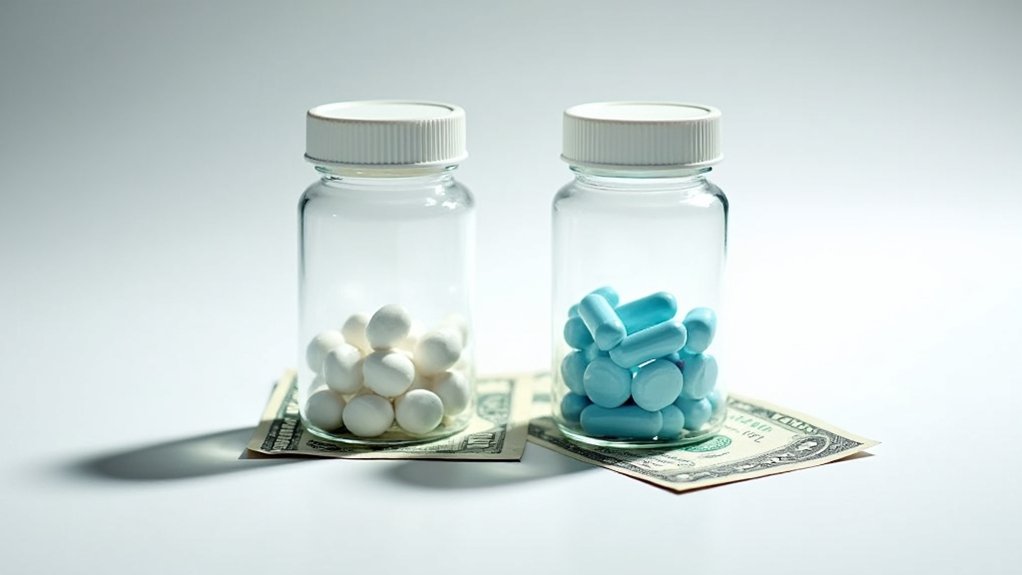Suboxone effectively combats opioid dependence through its unique dual-action formula of buprenorphine and naloxone. You’ll experience reduced withdrawal symptoms while the medication’s high receptor affinity blocks other opioids from binding. Its ceiling effect prevents overdose, and when combined with counseling, you can achieve up to 60% sustained abstinence rates. Treatment reduces hospital visits by 52% and mortality by 50%. Understanding Suboxone’s thorough approach reveals why it’s a leading solution for opioid recovery.
Understanding the Science Behind Suboxone

How does a medication effectively combat one of medicine’s most challenging conditions? Suboxone’s unique molecular design provides the answer through its sophisticated interaction with opioid receptors in your brain.
The medication’s partial agonism benefits create just enough receptor stimulation to prevent withdrawal while avoiding the intense euphoria that leads to addiction. Its high receptor affinity advantages mean it firmly attaches to and blocks these receptors, preventing other opioids from binding. The addition of naloxone component helps reduce potential abuse of the medication. You’ll find this blocking effect particularly vital, as it helps prevent relapse and overdose risks. When combined with counseling and behavioral therapies, this medication offers a comprehensive treatment approach.
The medication’s slow-acting, long-lasting properties maintain steady blood levels for 24-36 hours. This extended duration means you’ll need only one daily dose, while the controlled receptor stimulation gradually reduces your body’s opioid tolerance over time.
The Unique Ceiling Effect and Safety Features

Unlike traditional opioids that carry substantial overdose risks, Suboxone’s unique ceiling effect represents a breakthrough in addiction medicine safety. When you follow prescribed dosage guidance, you’ll benefit from multiple overdose prevention measures built into this medication’s design.
Suboxone’s innovative ceiling effect makes it a safer alternative to traditional opioids, protecting patients when taken as prescribed.
Key safety features of Suboxone include:
- A plateau in respiratory depression beyond moderate doses, preventing fatal overdose risks
- Naloxone activation if the medication is injected, triggering immediate withdrawal
- High receptor affinity that blocks other opioids from binding, reducing relapse risks
- Limited euphoric effects that don’t increase with higher doses, deterring misuse
These pharmaceutical safeguards work together to protect you during treatment. The ceiling effect means you won’t experience increased sedation or respiratory depression beyond therapeutic levels, making Suboxone considerably safer than full opioid agonists like methadone. The medication’s long half-life allows for convenient once-daily dosing while maintaining consistent protection against withdrawal symptoms.
Breaking Free From Full Opioid Dependency

Suboxone’s unique receptor blocking mechanism helps you avoid relapse by preventing other opioids from producing their typical euphoric effects.
Comprehensive rehabilitation programs combined with Suboxone treatment provide the best chances for sustained recovery. You’ll experience a more manageable withdrawal process as the medication stabilizes your brain chemistry through controlled receptor activation. Mental health conditions may need to be addressed alongside addiction treatment for optimal recovery outcomes.
The medication’s partial agonist properties create a smoother shift away from full opioid dependence while minimizing the intense physical and psychological symptoms that often trigger relapse. Buprenorphine’s long-term outpatient care helps patients maintain recovery through consistent medical support and monitoring.
Receptor Blocking Prevents Relapse
Three key mechanisms enable Suboxone’s powerful ability to block opioid relapse through its receptor interactions. Through its unique pharmacological properties, Suboxone delivers effective relapse prevention strategies while offering significant harm reduction advantages.
- You’ll benefit from buprenorphine’s high-affinity binding, which actively displaces other opioids and prevents them from activating receptors, even if you experience a momentary lapse
- The medication’s slow dissociation rate maintains steady receptor occupation, reducing your cravings and preventing the intense highs that drive dependency
- Its partial agonist properties provide just enough receptor activation to keep you stable without triggering euphoria
- The built-in “ceiling effect” means higher doses won’t increase opioid effects, protecting you from overdose risks while maintaining treatment effectiveness
Treatment with Suboxone can reduce mortality by 50% while helping patients achieve long-term recovery from opioid use disorder.
Smoother Withdrawal Through Stabilization
While breaking free from opioid dependency often presents considerable challenges, Suboxone’s thorough stabilization approach transforms the withdrawal process into a more manageable expedition. You’ll experience reduced severity of physical symptoms like nausea and muscle pain through its targeted receptor binding mechanism, enabling symptom stability during your recovery journey. Medical supervision during detox provides essential 24/7 support and monitoring. The medication’s buprenorphine and naloxone combination effectively deters misuse while providing relief.
The medication’s partial agonist properties prevent the full intensity of withdrawal symptoms while restoring balance to your brain’s neurotransmitter systems. Through gradual tapering, you’ll avoid extreme fluctuations in brain chemistry that typically accompany abrupt cessation. Clinical trials demonstrate that this controlled approach substantially improves your chances of maintaining long-term recovery by allowing consistent participation in therapeutic interventions. You’ll find yourself better positioned to engage in counseling and develop essential coping skills while maintaining neurochemical equilibrium.
Long-Lasting Treatment Benefits
Research demonstrates multiple long-lasting benefits of sustained Suboxone treatment for opioid dependence. Through proper dose optimization and patient personalization, you’ll experience significant improvements in your recovery process. Patients may need higher initial doses during the stabilization phase when transitioning from potent synthetic opioids like fentanyl. Studies show that 16mg or more helps minimize withdrawal symptoms and cravings during treatment.
Key long-term benefits include:
- 52% reduction in hospital admissions and 26% fewer emergency room visits when you maintain treatment for 15+ months
- 60% chance of achieving sustained abstinence after 3.5 years of consistent treatment
- 173% decrease in overdose risk through continuous therapy
- 50% of patients who achieve abstinence successfully move off medication maintenance
With doses exceeding 24mg daily, you’ll likely experience amplified treatment adherence and delayed need for emergency care. Your healthcare provider will tailor your treatment plan based on your specific tolerance and clinical needs, ensuring the most effective long-term outcomes. Studies show patients typically use opioids only 5 days per month by the end of long-term follow-up treatment.
Managing Withdrawal Symptoms Effectively
Effective withdrawal management during Suboxone treatment requires precise timing and systematic assessment of symptoms. You’ll need compassionate clinical guidance to navigate this critical phase, as your healthcare provider monitors your COWS score and guarantees you meet pre-induction criteria.
| Withdrawal Phase | Time Frame | Required Action |
|---|---|---|
| Pre-induction | 12+ hours after last opioid | Monitor for visible symptoms |
| Initial Assessment | 6-12 hours | Complete COWS evaluation |
| Peak Management | 48-72 hours | Individualized dosing strategies |
| Stabilization | Days to weeks | Adjust maintenance dose |
Your treatment team will implement individualized dosing strategies based on your specific needs. You’ll receive supervised initial doses, with careful monitoring for signs of precipitated withdrawal. This systematic approach, combined with proper hydration and continuous medical oversight, helps confirm a smoother progression through the withdrawal period.
The Path to Sustained Recovery
Your path to sustained recovery depends on meeting critical treatment milestones, including maintaining therapeutic doses for at least 12 months and achieving clinical stability through consistent medication adherence.
Research shows that patients using extended-release buprenorphine injectable demonstrated superior outcomes with a higher percentage of opioid-free weeks compared to placebo treatment. The data indicates that 28 percent of patients achieved treatment success when combining medication with counseling support. You’ll find greater success when you combine medication-assisted treatment with strong support systems and behavioral therapy, as evidence shows this integrated approach leads to higher abstinence rates.
Through extended treatment periods and stable medication levels, you’re 14 times more likely to achieve long-term recovery, particularly when using newer delivery methods like monthly injections or implants that eliminate daily dosing challenges.
Treatment Goals and Milestones
The course to enduring recovery through Suboxone treatment follows three distinct phases: induction, stabilization, and maintenance. Through careful induction timeline optimization and microinduction stabilization, you’ll progress through key therapeutic milestones. The process is strengthened by extensive research coverage spanning millions of scientific papers on addiction treatment protocols.
Your treatment expedition typically includes these evidence-based benchmarks:
- Initial 12-24 hour abstinence period followed by carefully monitored dosing, starting with 8mg buprenorphine/2mg naloxone
- Gradual dose increases over 3-8 days until reaching the target dose of 16mg buprenorphine/4mg naloxone
- Physical withdrawal symptom resolution within the first month, though psychological cravings may persist
- Long-term stabilization with 81% medication compliance rates, reducing relapse risk and supporting enduring recovery
This structured approach optimizes therapeutic efficacy while minimizing withdrawal discomfort, offering you a proven course toward opioid independence.
Support Systems Matter
Building upon the structured treatment phases, successful long-term recovery hinges on steadfast support networks and community connections. Your chances of sustained recovery increase drastically with long-term commitment and extensive support systems, as 3 out of 4 individuals achieve recovery through consistent engagement.
| Support Element | Impact on Recovery |
|---|---|
| Peer Programs | 57% of facilities offer peer support networks |
| Family Counseling | 83% of facilities provide family involvement |
| Recovery Attempts | Median of 2 attempts shows persistence need |
| Success Rate | 75% recover with sustained support |
| Community Resources | Treatment completion rises with access |
Through community involvement and dedicated support networks, you’ll navigate recovery challenges more efficiently. Treatment facilities recognize this by incorporating family counseling and peer support programs, creating accountability structures that optimize your recovery expedition.
Breaking Free Through Stability
Successful recovery from opioid dependence demands neurochemical stability, which Suboxone treatment effectively provides through its specialized mechanism of action. By mitigating side effects and supporting your brain’s chemical balance, Suboxone creates a foundation for regaining control of your life.
Through consistent treatment, you’ll experience:
- Reduced withdrawal severity and cravings, allowing you to focus on recovery rather than physical discomfort
- Stabilized mood and energy levels, preventing the extreme fluctuations common in early recovery
- Amplified ability to establish healthy daily routines and make clear-headed decisions
- Decreased risk of relapse and overdose, particularly during vulnerable early recovery periods
This neurochemical stability proves essential for sustainable recovery, enabling you to rebuild your life while maintaining the consistent brain chemistry needed for long-term success.
Frequently Asked Questions
Can I Drink Alcohol While Taking Suboxone?
You shouldn’t drink alcohol while taking Suboxone. Mixing Suboxone and alcohol is extremely dangerous due to their combined effects on your central nervous system.
Both substances depress your breathing and heart rate, which can lead to severe risky health effects, including overdose and death. Even small amounts of alcohol can intensify Suboxone’s sedating effects.
You’ll also reduce your treatment’s effectiveness and put unnecessary strain on your liver by combining these substances.
How Long Should I Expect to Stay on Suboxone Treatment?
Your treatment duration with Suboxone isn’t one-size-fits-all. While studies show a median of 50 days, many patients benefit from 6 months to over a year of treatment.
Your specific timeline will depend on your progress, stability, and medication adherence. You’ll work with your healthcare provider to determine the right length of treatment based on your individual needs and response.
Don’t rush to discontinue longer treatment periods are often associated with better outcomes.
Will Suboxone Show up on Employment Drug Tests?
Suboxone won’t show up on standard 5-panel or 10-panel employment drug tests unless specifically requested. However, its effects on employment could vary based on testing policies.
You’ll need to disclose prescribed Suboxone to your employer, as workplace implications may arise if detected on expanded panels. While private employers can test for it, they must respect ADA protections for prescribed use.
Always maintain documentation of your legitimate prescription to protect your employment rights.
Can I Get Pregnant While Taking Suboxone?
Yes, you can get pregnant while taking Suboxone, as it doesn’t affect your fertility.
You’ll need to discuss fertility planning with your healthcare provider since pregnancy requires careful management of your Suboxone treatment. It’s crucial to use effective contraception until you’re ready to conceive, as unplanned pregnancies can complicate treatment.
When you decide to get pregnant, your doctor will help create a specialized prenatal care plan that prioritizes both your health and your baby’s well-being.
How Much Does Suboxone Treatment Typically Cost Without Insurance?
Without insurance, you’ll typically pay around $195 monthly for Suboxone treatment. Your costs can range from $30 to $540 per month, depending on your dosage and whether you use tablets or strips.
Don’t worry there are several ways to make treatment more affordable. You can investigate financial assistance programs, manufacturer savings cards offering up to $170 monthly discounts, and payment plans through clinics. Many providers also offer sliding-scale fees based on your income.






